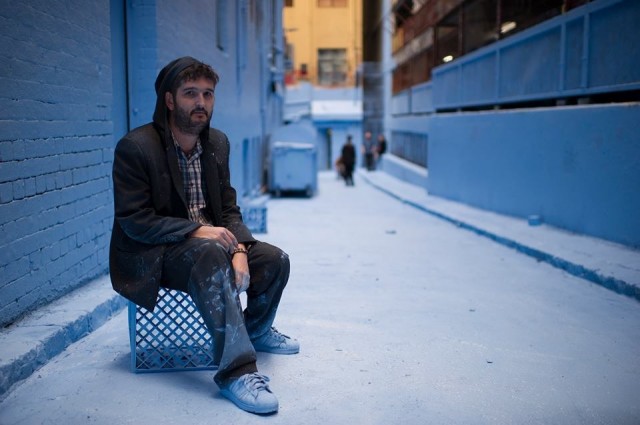
A couple of weekends ago on Sunday the 25th of August, I started walking down Hosier Lane, which I do at least 5 times a week, but this time I noticed something very strange. Rutledge Lane (located parallel to Hosier Lane – one of Melbourne’s most well known street art and graffiti locations) was completely fenced off and there were trucks and equipment. When I made it down to the other end, an even more surprising site met me.
It was Adrian Doyle (who I’ll tell you a bit more about later) in a full white body suit, spray gun in hand, starting to paint Rutledge Lane completely BLUE. An eery light blue glow came all the way to the edge of the lane with a distinct sharp blue line all the way to the edge of Hosier. What followed has been the talk of the Melbourne street art and graffiti community, and whilst it has calmed down now, or has even been forgotten, it definitely created quite a stir.
The ‘installation/artwork/buff?’ was not only the talk of the local street art and graffiti community, it also attracted much media attention on radio, TV and in newspapers due to the infamous nature of the lane way.
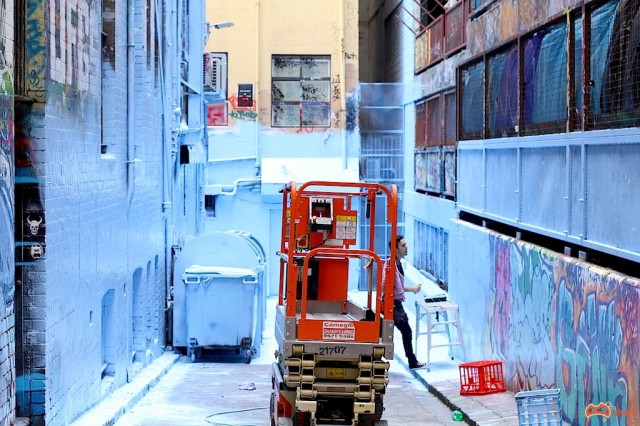
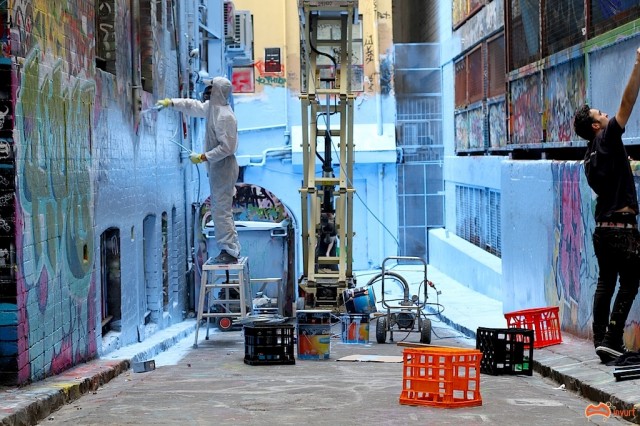
Adrian continued down the entire laneway and proceeded to buff everything in sight, and I mean everything, every bin, every spec of rubbish laying around, everything. Top to bottom, even the road. Scissor lifts and spray guns were his tools of choice to get as much paint up as high as he could.
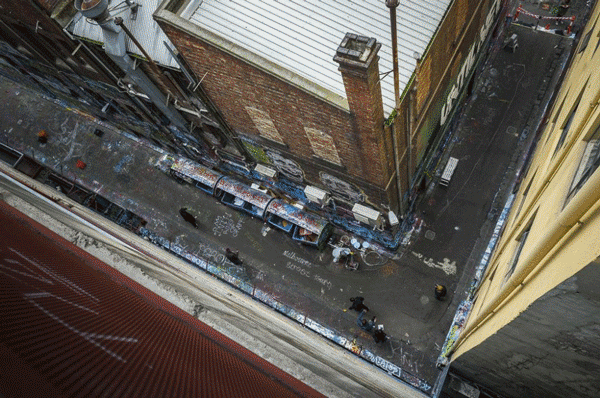
Later that day Invurt posted an article on the project, which contained Doyle’s explanation behind the project, taken from his Facebook page:
Today piece was not a buff….. it was a burner.. Hell yeaH…
Houses are a major influence on my aesthetics and imagery. Most of the important events in my early life were focused around our quarter acre block in the heart of suburbia. We had an outback toilet, complete with its own dunny man that came every week to change the bucket. We went through numerous above ground pools and sadly, many pets. My house was not really different than any other suburban house. Yet it was my world for many years, a curated world, in which I learnt social skills and perceived normality from my parents.
I watched from a very young age as my parents struggled with house payments and debt collectors. They worked so hard to pay the bills and bring up 5 kids. They worked in jobs they hated with little respect from their bosses. They married in their teens, and did all the expected norms and learnt behaviour passed down from their parents. The house was a symbol of their hard work.
This experience made me reflect on my childhood home, and the hold it had over me, my family and my art. When my parents eventually lost the house to the bank, my parents moved four hours away to a small cottage in East Gippsland. But the grief and pain followed them. I began to play with the idea of creating a colour that represents my childhood and my suburban experiences. Was it possible to create a colour that could capture that kind of experience?
So I decided to come up with my own colour. I named it: Empty-Nursery Blue
The way I decided to create Empty-Nursery Blue was by sitting in the studio and creating hundreds of different blues until I found the one that expressed my experiences the most. It was a baby blue that had hints of mauve in it. It’s a beautiful colour, a bright pastel. This colour expresses the feeling that something has been disturbed. All is not quite right. I took my disturbing yet beautiful colour to a paint lab and worked out its recipe.
But what good was Empty-Nursery Blue, if it was without a context. I needed to find something to paint to physicalise the concept of the colour.
As mentioned above, after losing their house, my parents moved to an island in the Gippsland Lakes. It’s a significant removal from the realities of suburban Frankston. Their house is alone in the landscape, only bushes and trees to keep it company. Not even a bridge links the island to the nearest shop. This physical removal from the past does not automatically come with emotional removal.
This is why I decided to paint my parents’ new house Empty-Nursery Blue.
Empty-Nursery Blue once placed in context became a symbol of a collective past. Surrounding the new house with the memory and emotions of an experience that ruptured my family’s suburban dream.
In recent years I have spent much of my time lost deep in the Melbourne Street Art world. Street art has become a major part of my life and the lane-ways have become my world. I have lived and breathed art all my life. My art, however, is conceived of and formed from my past experiences. I cannot exist today without recognizing my roots in the past.
Thus, I would like to incorporate my past and my present in a Street Art piece using the colour Empty-Nursery Blue, and only this colour. By using Empty-Nursery Blue to cover Hosier Lane, I am symbolically ‘coating’ my present with my past, it is reminder to me and anyone who is living, that you are a product of your former experiences, and you should be reminded of them as you work your way through your present and into your future. By doing this, I am claiming that a colour in its pure form can be street art or graffiti. This is a great conceptual link from fine art to street art, a link that is often lacking in the Melbourne Street Art scene. By bridging this gap, I hope to expose more people not only to Street Art, but also to the importance of art in general.
Doyle explains that his piece reflects the experiences of his childhood and his relationship with the suburban house, in particular the negative impact of his parents losing the house to the bank when he was young. “We’re all victims of suburbia” he said on a radio interview on 774. This all inspired him to create the “Empty Nursery Blue” colour.
Doyle claims the piece wasn’t a buff, but by nature it can’t really be called anything else. That doesn’t mean it wasn’t an interesting piece of art, although some argue it is not art, at all.
Doyle is no stranger to street art in Melbourne. He runs Blender Studios; Open since the birth of the circa 2000 street art explosion in Melbourne and home to so many of Melbourne’s best past and present street, contemporary and fine artists. Doyle also helps run the Signal Arts mentoring program which provides young kids paint and the opportunity to learn from some of Melbourne’s best street art and graffiti artists. He is a well known character in the closely connected Melbourne scene.
Does his intimate relationship with street art give him the right to paint an entire lane way blue though?
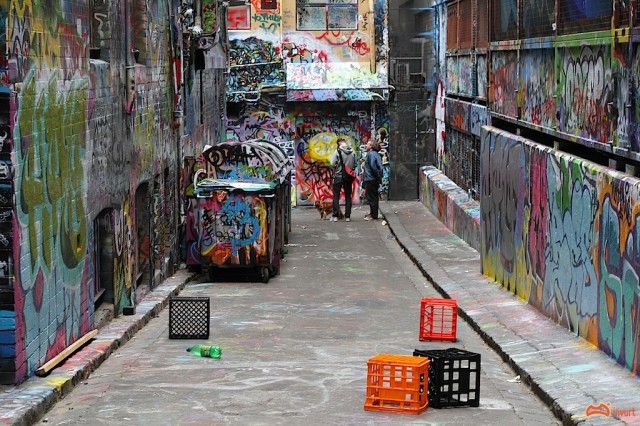
For readers not familiar with them, let me tell you a little about Hosier and Rutledge Lanes. Hosier Lane is Melbourne’s most renowned street art location by far – I say renowned, not best; because there are MUCH better places for street art and graffiti in Melbourne. Just open any Lonely Planet or travel book about Melbourne and you’ll see that it is considered as a must see tourist attraction. On any given day of the week, hundreds and hundreds of people (from all walks of life, ages and parts of the world) visit Hosier and Rutledge Lanes to see what amazing artwork has been left for them to admire. The lanes are also one of the most popular places in the city for wedding photographs, which I personally think is extremely tacky, each to their own through.
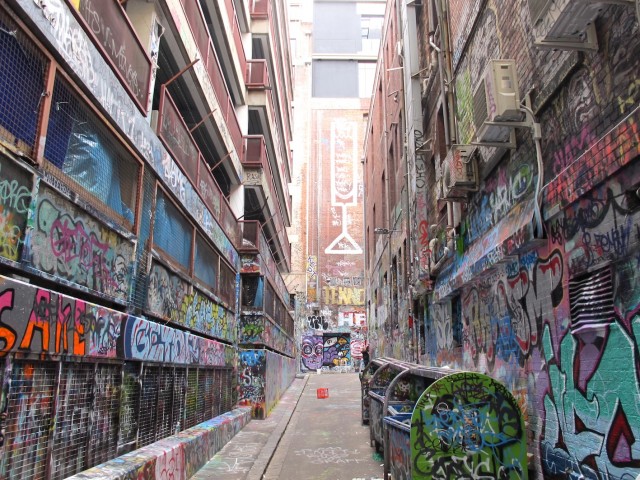
Hosier and Rutledge Lanes are close to the middle of Melbourne (off to the side a little) and are apparently a legal painting precinct, which means anyone can paint there, any time.
For many years the laneways were cared for and curated by a guy called Andy Mac, who used to run Until Never Gallery on the corner of Hosier and Rutledge Lanes. This kept the level of quality artwork fresh and relevant and to some extent meant that the lanes had a caretaker of sorts.
Since Andy left, Rutledge Lane in particular has gone downhill in terms of quality and in terms of respect shown to the work, unlike most other places people paint in Melbourne. I mentioned my disappointment in my July article at a piece by German artist MSYK getting capped almost immediately after being painted (at the time it was by far the best piece in the lane). This is what Rutledge Lane is like now.
More recently in particular Rutledge Lane has gained a reputation as a “practice spot”. This reputation definitely doesn’t do any favours for the longevity of pieces painted there or to encourage respect, an unspoken rule in most other places you find graffiti and to some extent street art. “Don’t cap what you can’t burn” is not a saying that generally holds true in Rutledge Lane.
All of that said, while the lane was a little out of control, the layer upon layer of paint and tags and sculptures, was a spectacle in itself. There really wasn’t many (so publicly accessible) places quite like it in Melbourne. It even caught the eye of Futura when he was last in Melbourne. From my interview with him: “Well that’s the fucking craziest street in the world, I mean, that one back alley, it’s like DONE. Jesus it’s impressive. Fuck, I mean, you gotta see it to believe it. I don’t care where you go, you know, Germany, Italy, France no no no, it doesn’t exist. Plus your architecture.. the lanes, just the set up.” Not everyone will agree with this opinion, but it was a pretty special place in hindsight.
Walking through the lane after Doyle had finished, was a pretty surreal experience, love or hate the project. The fact that every single surface was well and truly covered in bright blue buff and it was quite unique. The lane stayed fenced off for 45 minutes before it was opened back up to the public, and once the fences removed it didn’t’ take long for the cans to come out and some awesome burners to grace the new blue walls. (“Thanks for the Blue” – someone wrote). Sadly these pieces were capped with shit soon after. (Check out #RutledgeLane on Instagram or Flickr to see lots more shots, it changes daily).
What was I expecting though? One criticism of the project relating to this point, would be the lack of community consultation and engagement. Could this have had a different outcome if let’s say all the artists and writers were a) across the project, b) endorsed it, and c) aware of it happening? What if it had been discussed and debated? What if the majority of artists did support it, and organised to meet in the lane once it had been reopened, and repainted the new blank canvas? Would that have changed things? Could it have been one almighty refresh of Rutledge Lane?
Watching the event in time lapse is also fascinating. Personally I would still be filming the experiment, to see how long it takes for all the blue to disappear. I think this was also a bit of a missed opportunity; how fascinating would it be to watch it over 6 months or a year?
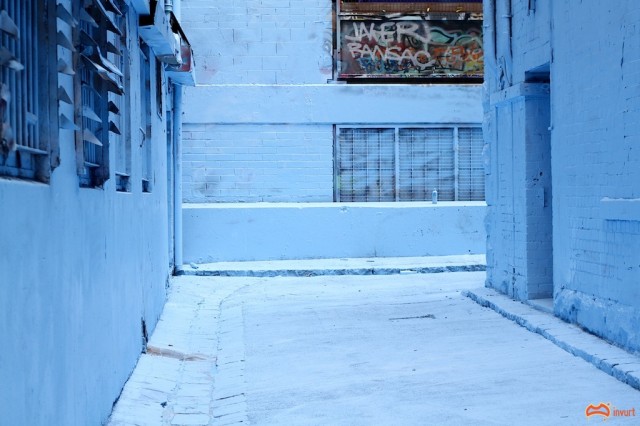
Another disappointment from my perspective was the lack of intelligent discussion this project generated. Not because it didn’t have potential to do so, but because most people are idiots. I found the reactions to this fascinating.
The majority of the reactions on Facebook and Blogs was just mindless insults and abuse. Some interesting (and ill informed) rumours too: “It’s for a new commercial,” “It’s the cops, they’ve baited the lane and they’re filming to catch people,” “It’s illegal to paint there now.” There were a few sensible and intelligent comments though. Along the lines of “It’s a fresh canvas”, “Nothing is permanent” or “Go down and paint your best stuff and stop complaining”.
Others complained that he destroyed a iconic place with some classic pieces. As Doyle says “the lane was trashed” there were no really significant pieces there except for maybe 2 or 3; as Acclaim Magazine rightly noted “in my opinion, it is a shame to see those Mic and Tekno rollers disappear” (those pieces were only still left intact because they were up so high). The rest of the lane way was a mess. And, it will be back before people realise, I bet.
I think one of the things that pissed many people off was the fact the project was endorsed and facilitated by RMIT University (a large institution) and (as it turned out) the City of Melbourne. Two of the least relevant authorities on street art. It was also interesting timing given the Lord Mayor had said he was “worried about the quality of the street art” in the Herald Sun only a week earlier.
Was it a kick up the arse the lane and the scene sorely needed? Was it a challenge to the community? Why has this lane become a “practice lane”? Is this what the painters of Melbourne want people to see when they visit “the most iconic street art and graffiti location in Melbourne”? (According to the public/tourists anyway). Or was the lane perfect, just the way it was?
I still don’t know exactly what I think about this very unique project. I can see so many good things about it, but I also understand many people’s negative opinions. For me the negatives were only in the execution, maybe missing out on some potential opportunities to make this project even more effective.
Anyway, it’s over now. I am looking forward to watching the evolution of the new Rutledge lane. I wonder how long, if ever, it will take for every drop of blue to be covered.
I’d be interested to hear what you think in the comments section below.
Photos courtesy of: Adrian Lagniton, Khoon Sorasiri via Art Fido, David Russell and Dean Sunshine
